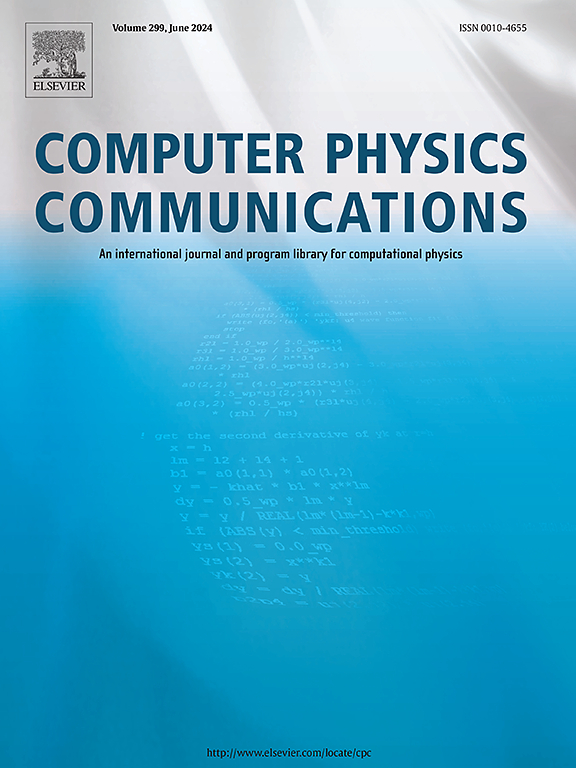Self-consistent charging of complex objects in flowing plasma: Implementation and analysis in WarpX
IF 3.4
2区 物理与天体物理
Q1 COMPUTER SCIENCE, INTERDISCIPLINARY APPLICATIONS
引用次数: 0
Abstract
The charging of conducting bodies in plasma environments is a fundamental process with implications spanning astrophysical, space, and laboratory plasmas. Accurate modeling of this charging process is essential for understanding and predicting the behavior of objects interacting with plasmas. In this study, we present the implementation of a charging algorithm in the open-source particle-in-cell code WarpX, which enables the simulation of charging for arbitrary 3D geometries in a plasma. The algorithm is verified against analytical solutions from orbital motion limited (OML) theory for a sphere in a static plasma and against published numerical results for a CubeSat in a flowing plasma. We investigate the charging of debris in Low Earth Orbit (LEO) conditions, considering both spherical and realistic debris geometries generated using a custom tool. The simulations reveal that the debris surface potential oscillates at the plasma frequency Doppler-shifted into the lab frame, a phenomenon not previously reported. The oscillations are robust to numerical convergence tests and persist for irregular debris geometries. Reduced density simulations suggest a critical threshold below which the oscillations disappear. Contrary to some earlier studies, precursor solitons do not form in our realistic LEO simulations, even with self-consistent charging of irregular debris. This study demonstrates WarpX's new capabilities for high-fidelity simulations of object charging in plasmas and highlights the complex nature of plasma-object interactions. The insights gained can inform the development of debris detection and mitigation strategies, while the WarpX code provides a valuable tool for future research in this field.
流动等离子体中复杂物体的自一致充电:在WarpX中的实现与分析
等离子体环境中导电体的充电是一个涉及天体物理、空间和实验室等离子体的基本过程。这种充电过程的精确建模对于理解和预测与等离子体相互作用的物体的行为至关重要。在这项研究中,我们提出了一种充电算法的实现,该算法在开源的细胞内粒子代码WarpX中实现,可以模拟等离子体中任意3D几何形状的充电。用轨道运动限制(OML)理论对静态等离子体中球体的解析解和已发表的流动等离子体中立方体卫星的数值结果对算法进行了验证。我们研究了低地球轨道(LEO)条件下的碎片充电,考虑了使用定制工具生成的球形和现实碎片几何形状。模拟结果显示,碎片表面电位以多普勒频移到实验室框架的等离子体频率振荡,这一现象以前没有报道过。振荡对数值收敛试验具有鲁棒性,并且对不规则碎片几何形状持续存在。降低密度的模拟表明存在一个临界阈值,低于该阈值振荡就会消失。与早期的一些研究相反,前体孤子不会在我们现实的LEO模拟中形成,即使不规则碎片的自一致充电也是如此。这项研究展示了WarpX在等离子体中高保真模拟物体充电的新能力,并强调了等离子体-物体相互作用的复杂性。所获得的见解可以为碎片检测和缓减战略的制定提供信息,而WarpX代码为这一领域的未来研究提供了一个有价值的工具。
本文章由计算机程序翻译,如有差异,请以英文原文为准。
求助全文
约1分钟内获得全文
求助全文
来源期刊

Computer Physics Communications
物理-计算机:跨学科应用
CiteScore
12.10
自引率
3.20%
发文量
287
审稿时长
5.3 months
期刊介绍:
The focus of CPC is on contemporary computational methods and techniques and their implementation, the effectiveness of which will normally be evidenced by the author(s) within the context of a substantive problem in physics. Within this setting CPC publishes two types of paper.
Computer Programs in Physics (CPiP)
These papers describe significant computer programs to be archived in the CPC Program Library which is held in the Mendeley Data repository. The submitted software must be covered by an approved open source licence. Papers and associated computer programs that address a problem of contemporary interest in physics that cannot be solved by current software are particularly encouraged.
Computational Physics Papers (CP)
These are research papers in, but are not limited to, the following themes across computational physics and related disciplines.
mathematical and numerical methods and algorithms;
computational models including those associated with the design, control and analysis of experiments; and
algebraic computation.
Each will normally include software implementation and performance details. The software implementation should, ideally, be available via GitHub, Zenodo or an institutional repository.In addition, research papers on the impact of advanced computer architecture and special purpose computers on computing in the physical sciences and software topics related to, and of importance in, the physical sciences may be considered.
 求助内容:
求助内容: 应助结果提醒方式:
应助结果提醒方式:


